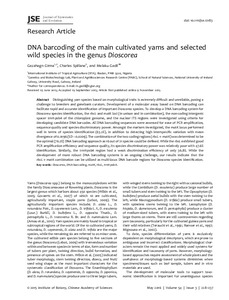| dc.contributor.author | Girma, G. |
| dc.contributor.author | Spillane, Charles |
| dc.contributor.author | Gedil, M. |
| dc.date.accessioned | 2019-12-04T10:57:53Z |
| dc.date.available | 2019-12-04T10:57:53Z |
| dc.date.issued | 2016-05 |
| dc.identifier.citation | Girma, G., Spillane, C., & Gedil, M. (2016). DNA barcoding of the main cultivated yams and selected wild species in the genus Dioscorea. Journal of Systematics and Evolution, 54, 228-237 |
| dc.identifier.issn | 1674-4918 |
| dc.identifier.uri | https://hdl.handle.net/20.500.12478/862 |
| dc.description | Article first published online: 9 November 2015 |
| dc.description.abstract | Distinguishing yam species based on morphological traits is extremely difficult and unreliable, posing a challenge to breeders and genebank curators. Development of a molecular assay based on DNA barcoding can facilitate rapid and accurate identification of important Dioscorea species. To develop a DNA barcoding system for Dioscorea species identification, the rbcL and matK loci (in unison and in combination), the non-coding intergenic spacer trnH-psbA of the chloroplast genome, and the nuclear ITS regions were investigated using criteria for developing candidate DNA barcodes. All DNA barcoding sequences were assessed for ease of PCR amplification, sequence quality and species discriminatory power. Amongst the markers investigated, the matK locus performed well in terms of species identification (63.2%), in addition to detecting high interspecific variation with mean divergence of 0.0196 (SD=0.0209). The combination of the two coding regions (rbcL + matK) was determined to be the optimal (76.2%) DNA barcoding approach as 16 out of 21 species could be defined. While the rbcL exhibited good PCR amplification efficiency and sequence quality, its species discriminatory power was relatively poor with 47.6% identification. Similarly, the trnH-psbA region had a weak discrimination efficiency of only 36.8%. While the development of more robust DNA barcoding systems is an ongoing challenge, our results indicate that the rbcL + matK combination can be utilized as multi-locus DNA barcode regions for Dioscorea species identification. |
| dc.format.extent | 228-237 |
| dc.language.iso | en |
| dc.subject | Dioscorea |
| dc.subject | Dna |
| dc.subject | Yams |
| dc.subject | Germplasm |
| dc.subject | Gene Banks |
| dc.title | DNA barcoding of the main cultivated yams and selected wild species in the genus Dioscorea |
| dc.type | Journal Article |
| dc.description.version | Peer Review |
| cg.contributor.crp | Roots, Tubers and Bananas |
| cg.contributor.affiliation | International Institute of Tropical Agriculture |
| cg.contributor.affiliation | National University of Ireland |
| cg.coverage.region | Africa |
| cg.coverage.region | West Africa |
| cg.coverage.country | Nigeria |
| cg.isijournal | ISI Journal |
| cg.authorship.types | CGIAR and advanced research institute |
| cg.iitasubject | Yam |
| cg.journal | Journal of Systematics and Evolution |
| cg.howpublished | Formally Published |
| cg.accessibilitystatus | Limited Access |
| local.dspaceid | 75414 |
| cg.targetaudience | Scientists |
| cg.identifier.doi | https://dx.doi.org/10.1111/jse.12183 |

